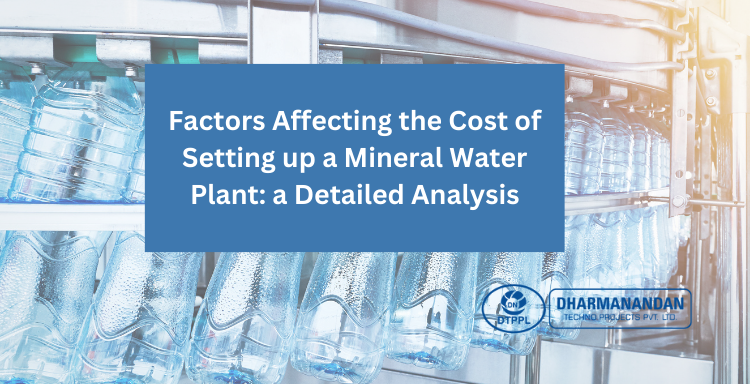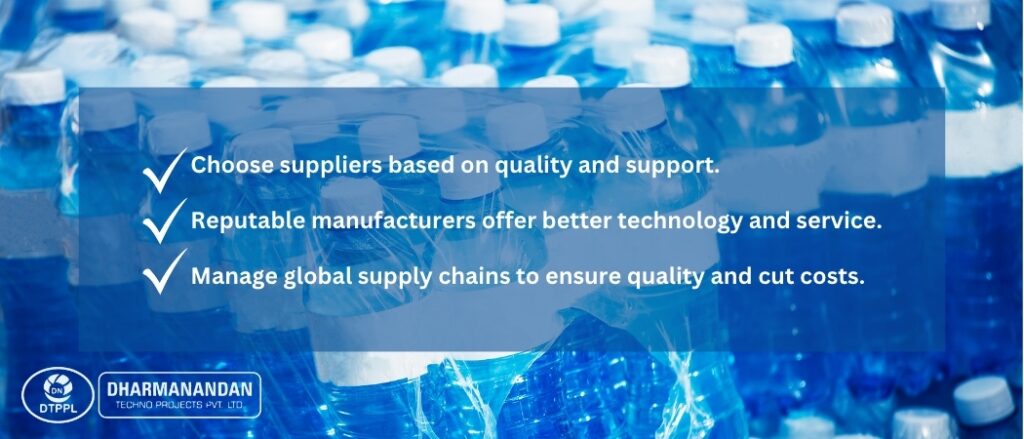
Table of Contents
Factors Affecting the Cost of Setting up a Mineral Water Plant: a Detailed Analysis
August 5, 2024
Introduction
The mineral water industry has seen a significant rise in demand over the past decade, attributed to growing health consciousness among consumers and an increased preference for bottled water over tap water due to concerns about quality and safety. Setting up a mineral water plant can be a lucrative venture but involves several critical considerations that influence startup and operational costs. From the choice of location and equipment to regulatory compliance and production capacity, each factor plays a pivotal role in determining the overall investment and profitability of the plant.
Section 1:
Preliminary Considerations – Understanding the Mineral Water Plant Process
A mineral water plant involves various processes such as extraction, purification, bottling, and packaging which need to be meticulously planned. The key to a successful setup lies in understanding each step’s intricacies—from sourcing the water from a reliable underground or surface source to employing processes like filtration, reverse osmosis, mineral addition, and final UV sterilization to ensure the water meets health safety standards before it reaches the consumer.
Regulatory Requirements and Compliance
Compliance with local and international standards is crucial for operating a mineral water plant. These regulations ensure the safety and quality of the water produced and covers aspects ranging from the source water quality to the materials used in bottling and packaging. Failure to comply can result in legal issues and substantial fines, making it essential for plant owners to invest in proper legal advice and compliance checks before commencing operations.
Location Factors: Impact on Costs
The location of the mineral water plant significantly affects the initial and ongoing costs. Strategic location decisions should consider proximity to water sources, target markets, and accessibility to transportation networks. Additionally, local labor costs, utility availability, and real estate prices can dramatically impact overall expenses. Choosing the right location can optimize distribution logistics, reduce overhead costs, and increase the plant’s overall efficiency and profitability.
Section 2:
Core Equipment Needs – Overview of Essential Mineral Water Machines
Investing in high-quality mineral water machines is crucial for efficient plant operation. Core equipment includes water treatment systems, bottling machines, and quality control apparatus. Each piece of machinery must be selected based on capacity, reliability, and compatibility with other plant components to ensure seamless production flow and maintain consistent product quality.
Choosing the Right Mineral Water Equipment
Selecting the right equipment for a mineral water plant involves balancing cost with performance. While higher-end machines offer greater efficiency and longer life spans, they also come with higher price tags. Potential plant owners should consider factors such as production speed, automation level, energy consumption, and after-sales service from manufacturers, as these will significantly impact production capacity and operational costs.
Cost Comparison of Mineral Water Bottle Filling Machines
Water Bottle filling machines vary widely in terms of cost, speed, and technology. High-speed automated filler reduces labor costs and increases production rates but requires a higher initial investment. Conversely, a semi-automatic or manual machine might cost less upfront but can lead to higher long-term labor expenses and lower production output. A thorough cost-benefit analysis can help in making an informed decision that aligns with the plant’s budget and production goals.
Advanced Technologies in Water Treatment
Incorporating advanced water treatment technologies can enhance the efficiency and effectiveness of the purification process. Techniques such as ultraviolet filtration, ozonation, and advanced reverse osmosis systems not only ensure superior water quality but also offer long-term cost savings by reducing waste and energy consumption. Although these technologies require higher initial investments, they can lead to significant operational cost reductions and better compliance with stringent quality standards.
Section 3:
Production Capacity – Determining Your Plant’s Production Scale
Deciding on the production scale of a mineral water plant is a crucial financial decision. It should be based on thorough market research, available capital, and long-term business goals. A smaller-scale operation might be less costly to start but can limit potential profits. In contrast, a larger-scale facility, while expensive, can cater to a broader market and benefit from economies of scale, potentially offering greater profitability over time.
Cost Implications of Scaling Production
Scaling up production involves not only increasing the output but also managing the higher costs associated with larger operations. These include investments in additional or more advanced machinery, increased labor, higher raw material costs, and expanded facility space. However, scaling up can also mean lower per-unit costs and improved bargaining power with suppliers, leading to better margins.
Efficiency vs. Investment: Finding Balance
Finding the right balance between efficiency and investment is critical for the financial health of a mineral water plant. While investing in state-of-the-art equipment and technologies may entail higher upfront costs, it can lead to substantial efficiency gains, lower operational costs, and higher product quality. Conversely, under-investing might save money initially but can result in higher maintenance costs, lower efficiency, and potential loss of market competitiveness.

Section 4:
Quality Control and Safety Standards – Essential Quality Control Measures
Quality control is paramount in the mineral water industry to ensure product safety and consumer trust. Implementing rigorous testing procedures at different stages of production, from water sourcing to final packaging, helps in maintaining consistent product quality. Regular audits and updates to the QC processes also play a crucial role in adapting to new regulations and consumer expectations.
Safety Equipment and Protocols
Ensuring the safety of both the product and the workplace is essential. This involves investing in proper safety equipment for handling chemicals and machinery, implementing strict protocols for operations and emergency responses, and regular training for all employees. These measures not only help in preventing accidents but also ensure compliance with occupational health and safety standards.
Additional Costs for Certification and Testing
Obtaining certifications such as ISO, NSF, or local equivalents can significantly enhance the credibility of a mineral water plant but comes at a cost. These include fees for the certification process, regular audits, and possibly additional investment in equipment or processes to meet certification standards. However, the benefits in terms of marketability and consumer trust often outweigh these costs.

Section 5:
Water Source and Treatment – Assessing Water Quality and Sources
The quality of the source water is the cornerstone of a successful mineral water plant. It needs to be free of contaminants and rich in natural minerals, which are appealing to consumers. Regular testing and monitoring of the water source are essential to ensure it meets legal and quality standards, which can involve significant ongoing costs for laboratory tests and quality control measures.
Setup Costs for Mineral Water Treatment Plants
The initial setup costs for a water treatment system depend on the chosen technology and the plant’s capacity. Components like filters, UV sterilizers, and pumps must be tailored to handle the specific type and volume of water processed, which can lead to significant variability in prices. Additional considerations include the costs for integrating these systems into existing plant operations and potential civil works required.
Ongoing Costs for Water Purification
Running a water treatment system involves ongoing expenses such as energy consumption, replacement of filters, chemicals for water conditioning, and routine maintenance. These costs must be carefully managed to maintain profitability, requiring efficient operation schedules, regular servicing of equipment to prevent breakdowns, and bulk purchasing of consumables to reduce expenses.
Section 6:
Packaging and Distribution – Choosing the Right Mineral Water Packaging Machine
The choice of packaging machinery directly impacts production efficiency and product quality. Factors to consider include the type of bottles being filled (glass vs. plastic), the speed of the production line, and the level of automation desired. While advanced machines with high throughput and automation levels are expensive, they reduce labor costs and increase production rates, which can improve profit margins in the long run.
Cost Analysis of Bottle Making vs. Buying Pre-made
Manufacturing bottles in-house allows for greater control over production and can reduce costs per unit, but it requires significant capital investment in equipment and raw materials. Alternatively, purchasing pre-made bottles can reduce upfront costs and complexity but may result in higher long-term costs and less flexibility in bottle design and supply.
Distribution Network Setup and Costs
Developing an efficient distribution network is key to ensuring that the bottled water reaches the market in optimal condition and at a reasonable cost. This includes considerations for transportation logistics, warehouse management, and handling costs. Establishing strong relationships with logistics providers can help reduce costs and improve delivery times, which is crucial for maintaining product quality and customer satisfaction.

Section 7:
Operational Costs – Labour and Training Expenses
Labor costs are a significant part of running a mineral water plant. Competitive wages, ongoing training, and employee benefits are essential for maintaining a skilled and motivated workforce. Additionally, investing in automation can reduce the reliance on manual labor, which can decrease long-term labor costs but requires upfront investment in technology and training.
Maintenance and Upkeep of Equipment
Regular maintenance is crucial to avoid unexpected breakdowns and extend the lifespan of the machinery. This includes scheduled servicing, replacement of worn-out parts, and immediate repairs of faulty equipment. While these activities incur costs, they are less expensive than major repairs or replacements that could result from neglecting regular maintenance.
Utilities: Power and Water Usage
Utilities like electricity and water represent recurring expenses that can fluctuate based on production levels, efficiency of the equipment, and local utility rates. Optimizing the use of energy-efficient machines and water recycling systems can significantly reduce these costs, contributing to the sustainability and profitability of the plant.

Section 8:
Financial Planning and Support – Understanding Mineral Water Plant Costs
Comprehensive financial planning is essential to manage the costs of setting up and running a mineral water plant. This includes detailed budgeting, cost forecasting, and financial performance monitoring. Clear understanding and management of costs help in making informed decisions about investments, cost-saving measures, and pricing strategies.
Options for Financing Your Mineral Water Plant
Various financing options are available for setting up a mineral water plant, including bank loans, investor funding, and government grants. Each option comes with its own set of conditions, advantages, and challenges. Effective financial management and solid business planning can improve access to these financial resources and ensure the plant’s long-term viability.
Subsidies and Support from Government
Many governments offer subsidies and support programs to promote the manufacturing sector, including the food and beverage industry. These may include tax incentives, reduced tariffs on imported equipment, and grants for technology upgrades. Staying informed about these opportunities can provide significant financial relief and support business growth.
Section 9:
Supplier and Manufacturer – Considerations Selecting a Mineral Water Plant Supplier
Choosing the right mineral water plant supplier for equipment and materials is critical to the success of a mineral water plant. Factors to consider include supplier reputation, the quality of the products, after-sales support, and the ability to provide customized solutions. Building a long-term relationship with a reliable supplier can lead to better service, more favorable pricing, and priority support.
Long-term Benefits of Partnering with Reputable Manufacturers
Partnering with reputable manufacturers offers numerous benefits, including access to the latest technology, reliable equipment, and professional advice. These relationships can also provide warranty services, training for staff on new equipment, and updates on industry trends, which can significantly enhance operational efficiency and product quality.
Navigating the Global Supply Chain for Equipment
Managing a global supply chain involves challenges such as dealing with international suppliers, fluctuating exchange rates, and logistical complexities. Effective supply chain management can help minimize costs, ensure timely delivery of equipment and materials, and maintain consistent quality standards.

Section 10:
Additional Factors – Environmental Impact and Sustainability Practices
Environmental sustainability is increasingly important in the mineral water industry. Implementing practices such as waste reduction, energy conservation, and sustainable sourcing can not only reduce environmental impact but also improve the brand’s image and appeal to eco-conscious consumers. Moreover, compliance with environmental regulations can prevent legal issues and potential fines.
Innovations in Mineral Water Processing
Technological innovations continue to transform the mineral water industry, offering new ways to improve quality, reduce costs, and increase efficiency. Staying updated with these advancements can provide competitive advantages, such as adopting energy-efficient systems, using advanced filtration technologies, and implementing IoT for better process control.
Future Trends in the Mineral Water Industry
The mineral water industry is subject to shifts in consumer preferences, regulatory changes, and technological advancements. Understanding these trends can help anticipate market movements, adapt business strategies accordingly, and ensure the plant’s long-term success. This includes exploring new market segments, adapting to consumer preferences for flavored and fortified water, and leveraging digital marketing.

Director – Global Marketing and Sales
Mr. Bhavesh from Dharmanandan Techno Projects Pvt. Ltd. has played a pivotal role in elevating the DTPPL brand to the global stage, leveraging his exceptional expertise in marketing and communications. He is committed to helping clients achieve significant growth while strengthening their own brands. Dharmanandan Techno Projects Pvt. Ltd. is a leading manufacturer and supplier of water purification systems and turnkey solutions for mineral water plants. With years of experience in designing and delivering high-quality water treatment solutions, the company provides end-to-end services, including system design, installation, maintenance, and ongoing support. Specializing in scalable and customizable water plants, DTPPL has successfully served industries worldwide, ensuring clean and safe drinking water across diverse applications.
